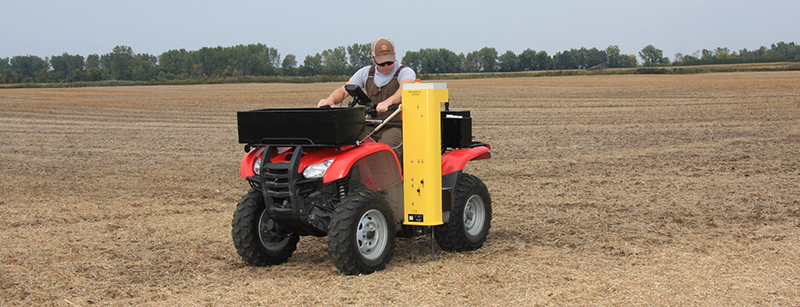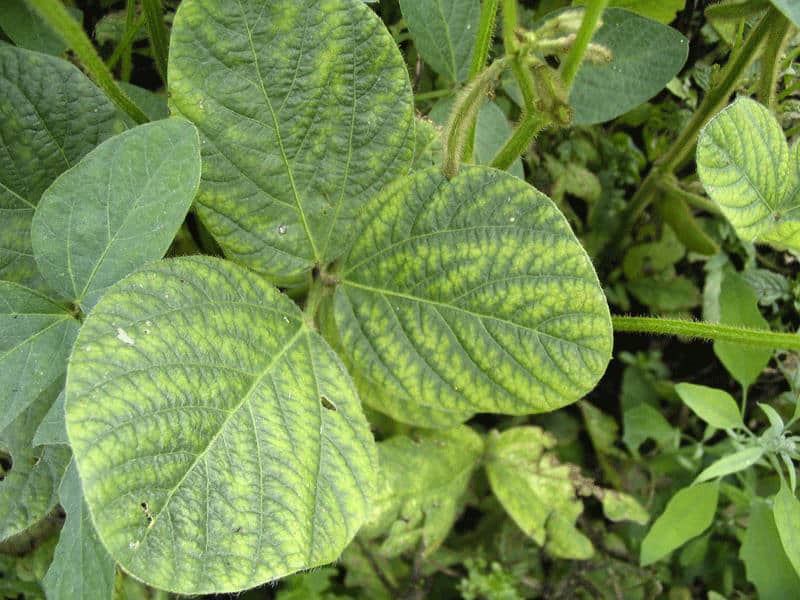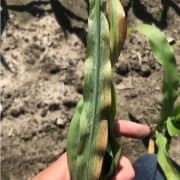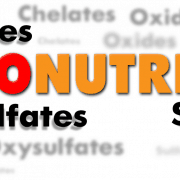Micronutrients — more important than you think
Micronutrients are essential to plant growth and aid in achieving yields that growers need. Unlike a macronutrient such as nitrogen, phosphorus and potassium, micronutrients are required by the plant in small amounts, but are equally as important for proper crop growth and yield. The micronutrients that are key to growth include Boron, Copper, Iron, Manganese, Molybdenum, Chloride, and Zinc.
Photo: Manganese deficiency in soybeans
If micronutrient levels are low in a soil, plant abnormalities and reduced or retarded growth, can occur. Often a micronutrient can be a limiting factor in your soil, and when this is the case your yield potential will be lower.
How to diagnose micronutrient deficiencies

Zinc deficiency in corn
The best ways to diagnose micronutrient deficiency is with a soil test, perform a plant tissue analysis, or request a Thompsons Soil Solutions test (a test that is exclusive to Thompsons).
If you suspect a micronutrient deficiency in a crop, collect plant samples from both healthy and unhealthy areas. Your Thompsons Ag Consultant can advise you where (on the plant) to take the sample. Taking a soil sample from the same location can help you understand and confirm the deficiency that is occurring, and help you decide on corrective measures to take. Remember though that it shows total quantity of that nutrient in the soil–not availability. As a soil’s pH rises, micronutrients will become less available and will be tied up in the soil.
Micronutrients can be applied foliar, broadcast, or banded. Foliar applications can be a good way to help correct deficiencies for the current crop season, but will not fix the entire problem in the long term. Banding or placing in a starter fertilizer will allow for the most uptake and availability of the micronutrient. When micronutrient deficiencies are more severe starter fertilizers alone will not alleviate the problem. Broadcasting and foliar applications may still be needed.
Micronutrients that are key for growth
Boron
Cell wall strength and division, sugar transport and fruit and seed development occur with proper boron nutrient levels. Alfalfa, sugar beets, red clover, and brassica crops have the most response to boron. Deficiencies may occur on sandy soils, or highly weathered soils which are low in organic matter. Basic soils with high pH can also show deficiency signs. Soils with a CEC less than 20, should be at 1.5 ppm. Anything less will require an application.
Copper
Seed production, chlorophyll formation and enzyme activity will occur with proper copper levels. Wheat, oats, and alfalfa have a high response to Copper. Deep sandy and light loamy soils are prone to a deficiency, as well as low organic matter farms, and soils with a pH less than 5.3. Around 3 ppm is optimal in your soil. Anything else and applications may be needed, dependant on crop type.
Manganese
Chloroplast formation, photosynthesis and the synthesis of various enzymes occur with proper manganese levels. Soybeans, dry beans, peas, potatoes and wheat have a high response to Manganese. Soil with a pH above 6.5 commonly will show a deficiency. Soil test levels of 33 ppm or greater are optimum. Anything less than 33 ppm could require an application. Any levels less than 10 ppm will inhibit root growth. Be aware if your levels are low and you are planning an application of Lime. You will raise the pH and induce more deficiency.
Zinc
Plant chlorophyll is produced with proper zinc levels. Commercial corn, sweet corn, and dry beans have a high response to zinc. Sandy or low organic matter soils tend to be more prone to deficiencies, as well as muck or peat soils. Soil pH above 7 can also show deficiencies, since high soil pH causes Zinc not to become available. Levels of 5 ppm are optimum. Anything less and applications will need to occur.
Iron
Tomatoes, dry beans, forage grass, soybeans, and sugar beets have a high response to Iron. pH between 7.4-8.5 can show an iron deficiency. It usually occurs in cool wet soils. Organic matter improves iron availability. Soil levels of 25 ppm is optimal, and anything less than that could require an application. In general, iron is not an issue in Ontario.
Tips
- Always remember micronutrient applications can be toxic if too high of amount is applied or if applied to a sensitive crops. If levels are higher, it does not mean the micronutrient is available. You may want to still apply the micronutrient foliar or in a band.
- Always remember your pH. As pH rises, micronutrients become less available, so therefore applications in foliar or banded could be needed.
- When selecting your source you need to be aware of the convenience of the application, your effectiveness, cost per unit, and compatibility of your fertilizers.
Attention to the availability of micronutrients for field crops is just good management!
Sources: TRI-State Fertlizer Recommendations for Corn, Soybeans, Wheat & Alfalfa www.agry.purdue.edu.










